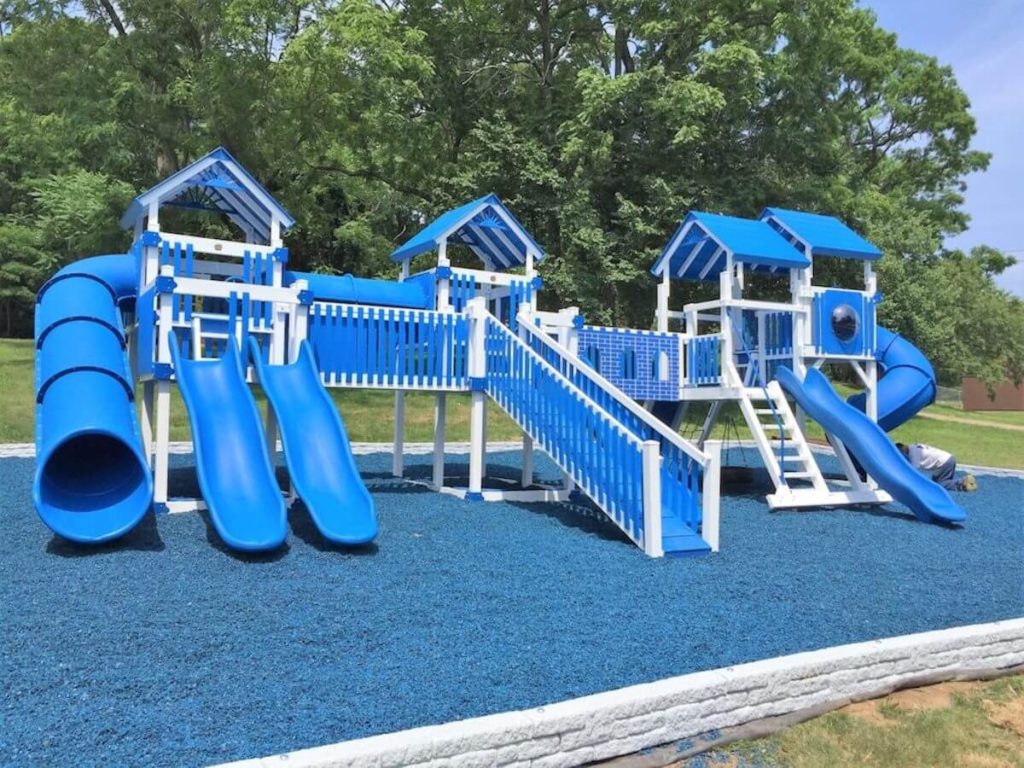There is a large list of options when it comes to choosing the ground beneath your swing set, each with their advantages and disadvantages. So, what should you put under a swingset? Our experts have laid out their recommendations.
The best material to put under your swing set can vary based on the age the playground is intended for, the height of the swing set or playground, and the area your swing set is in. However, we believe the material that’s the most well-rounded is rubber playground mulch. We recommend using rubber playground mulch for all ages except toddlers. Playgrounds intended for toddlers should use rubber mats that meet American Society for Testing and Materials (ASTM) standards.
Rubber playground mulch is low-maintenance, has great impact absorption, has a variety of color options to match the swing set/landscaping, and has a low lifetime cost. The cost may seem expensive upfront. However, as it is durable and lasts a long time with little maintenance, it has a lower lifetime cost.
We strongly believe safety should guide your decision more than any other factor. Our children should be able to play with the least risk of getting hurt. Cost, maintenance, and visual aesthetics matter as an owner, but we place these characteristics after safety in terms of priority. This is why we recommend taking this decision seriously, and why we stand behind the safest materials.
What Other Materials Can You Put Under The Swing Set
It may not seem to be a big deal, but certain materials are more likely to prevent life-threatening injuries than others, depending on the type of fall. The number of options and considerations can be overwhelming.
You must also consider the safety, cost, maintenance, and visual aesthetic of each different option. It can be a difficult decision! We want to help you, so we’ve compiled an extensive guide to help you choose the right playground surface that fits your lifestyle and needs.
Let’s explore the different types of surfaces that are common options for playground use and review their pros and cons. There are two categories for the types of playground surfaces: loose-fill materials and unitary surfaces.
Loose-fill materials:
Unitary surfaces:
For each type of surface, we will discuss safety, cost, maintenance, and visual aesthetics. These options are in no particular order.
Types of Playground Surfacing: Loose-Fill Materials
Wood Playground Mulch / Engineered Wood Fiber (EWF)
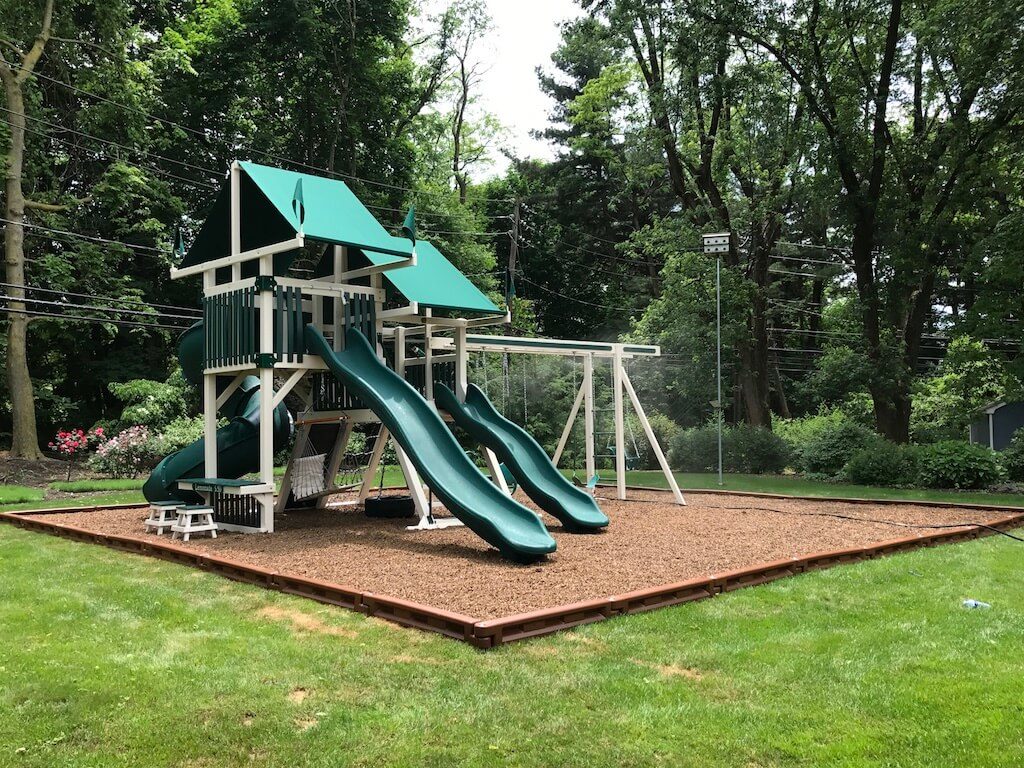
Safety
Wood playground mulch is a fairly safe option. Wood mulch offers decent shock absorption, as nine inches of wood mulch can protect against falls of up to seven feet. Surfacing playgrounds with wood mulch also offers good slip resistance, as it absorbs and drains moisture.
Some negative aspects related to safety include:
- Wood being susceptible to mold or insect inhabitants.
- The possibility of it hiding hazards (e.g. broken glass).
- The potential to freeze in the winter.
- Chance of getting splinters.
- The potential for heavily trafficked areas to spread out and be less effective.
One other thing to consider is that mulch can be a choking hazard. In general, loose-fill options should be avoided for playgrounds intended for toddlers.
Cost
Wood mulch generally costs less up-front and is easy to install. Mulch is also readily available. Although the cost is lower than other options, such as rubber mulch or rubber mats, the maintenance costs are higher. Wood mulch needs to be replaced yearly and requires ongoing raking to ensure optimal coverage.
Maintenance
There are a number of things to consider when it comes to maintaining wood mulch. Mulch compacts and decays, so it is important to replace and/or top off as it wears down. Mulch can be messy and end up all over the yard or playground outside of the swing set area, so clean up is a regular task. As mulch gets moved around in higher trafficked areas it will need redistributed to ensure safety in those spots. Adding a commercial fanny pad at the end of slides can help add some cushioning and keep mulch in its place.
Visual Aesthetic
Wood mulch has a pleasing natural aesthetic that can match any type of landscaping you have. Wood mulch also comes in a variety of colors, making it easier to match your property. The three most common color options are red, brown, and black.
Mulch is inexpensive, natural, and environmentally friendly, which contributes to it being used in the majority of playgrounds. But are there better options?
Rubber Playground Mulch
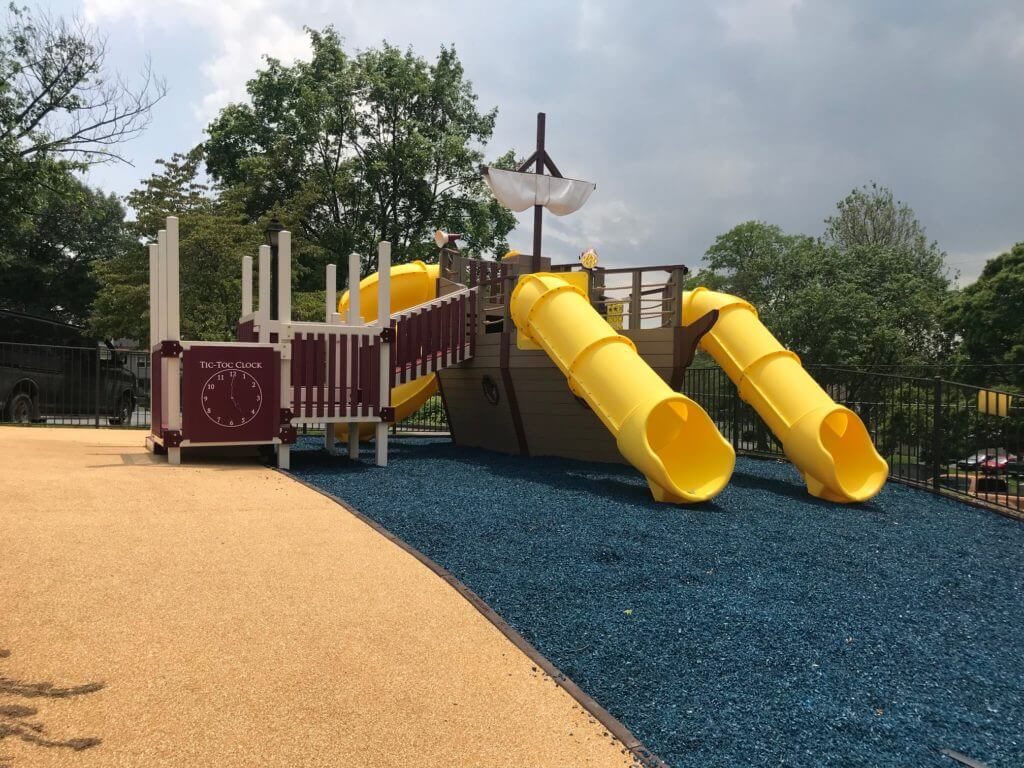
Safety
Rubber playground mulch provides the greatest impact absorption of all materials. Six inches of rubber mulch can protect for falls up to ten feet. Like wood mulch, rubber mulch also has the potential for displacement, so it should be monitored to ensure highly-trafficked areas have enough coverage.
Cost
Rubber playground mulch costs more initially in comparison to grass, wood mulch, pea gravel, and sand. Although the up-front cost is higher, it holds its value longer and requires less maintenance.
Maintenance
Rubber playground mulch is a low-maintenance surfacing option, which is why it tends to be more expensive at first. Unlike wood mulch, rubber mulch does not need to be replaced yearly, and may never need to be replaced at all. Rubber mulch is durable, easy to install, and only requires a little bit of raking to ensure even distribution and remove any debris.
Visual Aesthetic
Rubber playground mulch doesn’t look as natural as wood mulch, but it does come in earth tones. You can choose from a variety of different colors that you can match your decor, landscape, or the swing set itself!
Pea Gravel
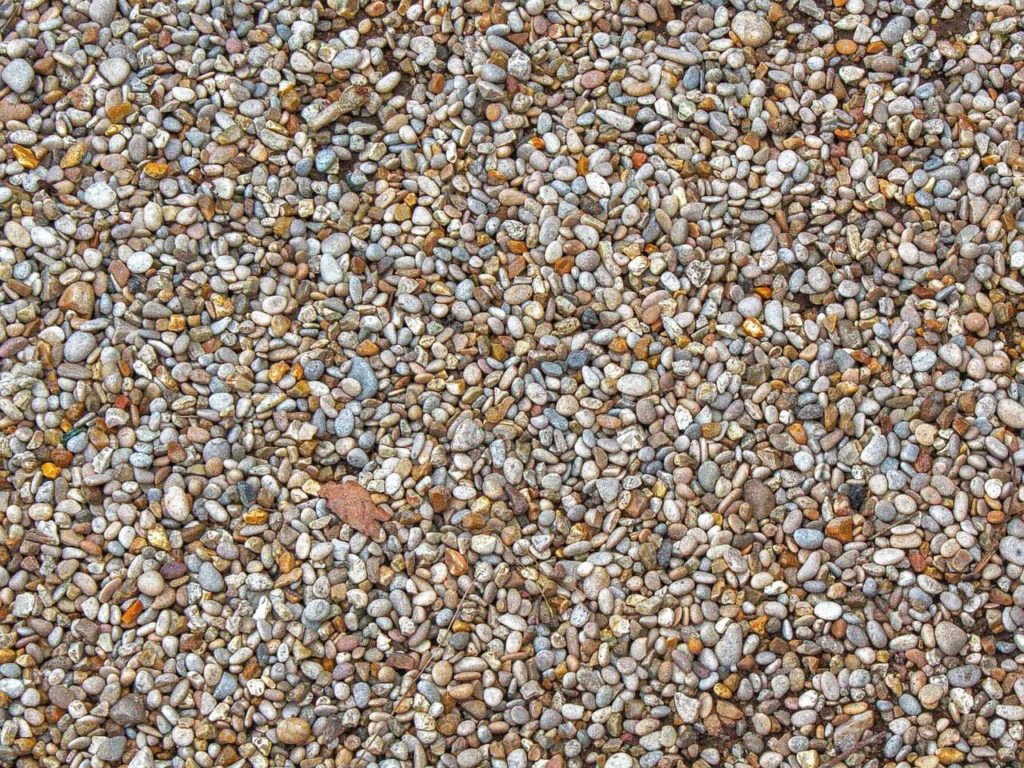
Safety
Pea gravel does not offer the best impact absorption, but it does offer some support. Nine inches of pea gravel protects for falls up to five feet. This type of loose-fill can also compress and redistribute when used heavily, so it should be shoveled/raked regularly.
When it comes to cleanliness, pea gravel stays relatively clean and does not support the growth of microbial organisms. It’s also less attractive to animals than sand. Loose-fill surfaces like pea gravel are not recommended for playgrounds intended for toddlers, as it can be a choking hazard. Pea gravel does not meet ADA accessibility standards and can be difficult to navigate for people with disabilities.
Cost
Pea gravel has a low initial cost, but high maintenance costs. Pea gravel can break down over time and will need to be replaced to ensure optimal safety, which can add up in the long run.
Maintenance
As pea gravel is used and it endures the elements, the pieces break down into smaller particles. These smaller particles can form what’s called a “hard pan” which can be hard to break up and harmful if fallen on. When this happens, pea gravel should be replaced. More regular maintenance includes shoveling/raking to redistribute the gravel for the best injury prevention.
Visual Aesthetic
Pea gravel offers a natural look because it’s comprised of small stones. It’s also sometimes used as a lower-maintenance replacement for grass.
Sand
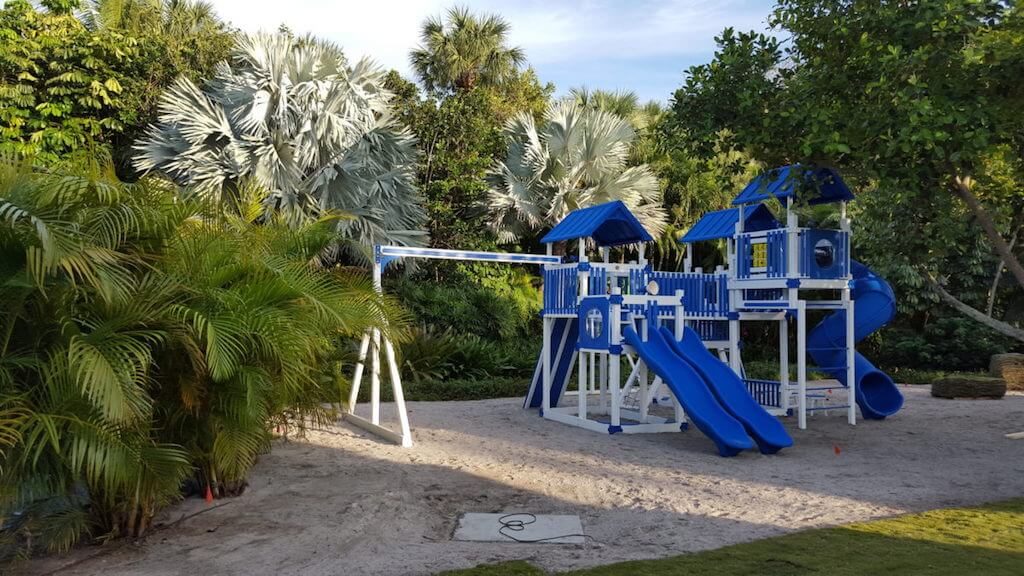
Safety
Sand is the least effective loose-fill playground material in terms of impact-absorption. Nine inches of sand protects for falls up to four feet. Similar to pea gravel, sand also does not meet ADA accessibility standards and may be difficult for people with disabilities to navigate.
Cost
Sand is a low-cost option that’s readily available and easy to install. Lifetime costs can add up though, as regular maintenance is necessary to keep sand clean and play ready. Sand should be replaced at least once a year or more if it becomes dirty quickly.
Maintenance
Sand can be time-consuming and difficult to maintain because it attracts animal waste, insects, and can hide harmful materials or objects. Redistribution will happen as kids play in the sand, so it’s important to rake and level the sand back to a uniform surface. Sand should be replaced every year or as often as necessary. If the sand is exposed to the elements, it may become dirtier faster and need to be replaced more frequently.
Visual Aesthetic
Sand offers a natural aesthetic and can match most landscapes when it is kept clean.
Types of Playground Surfacing: Unitary Surfaces
Poured Rubber & Rubber Tiles
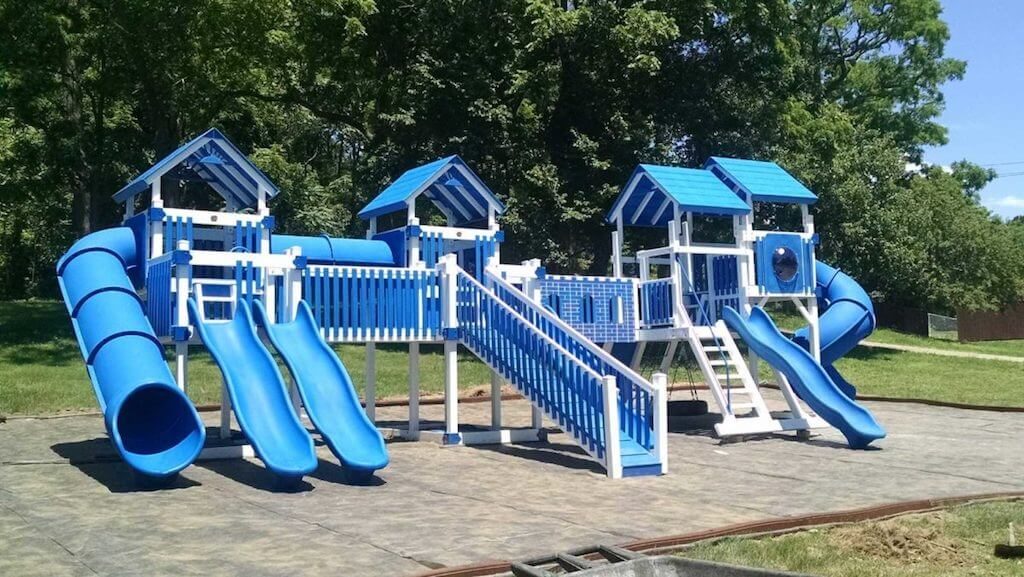
Safety
Rubber mats can be safe if they meet the American Society for Testing and Materials (ASTM) standards. When purchasing mats, it is very important to ensure they meet these standards. Rubber mats ensure nothing harmful can fall in-between, which isn’t necessarily the case with mulch. Mats are the ideal solution for any playground that’s intended for toddlers. Another thing to consider is that dark mats can be painfully hot to the touch if they’re in direct sunlight for an extended period of time.
Cost
The cost of rubber mats can vary greatly depending on the quality and manufacturer. However, they’re similar to rubber mulch because they’re more expensive than wood mulch, pea gravel, and sand. Mats are also similar to rubber mulch because they have a higher up-front cost, but low maintenance costs.
Maintenance
Rubber mats have very little maintenance costs and are easy to take care of. They should be swept or washed when necessary, but other than possible replacement of damaged sections, mats will last a very long time with little upkeep.
Visual Aesthetic
Rubber mats can vary in the way they look and can be made to fit your preferences. They don’t offer the same natural feel as mulch, but there are various color options to choose from. In general, the lighter the color, the better, especially if it they’re going to be in direct sunlight.
Grass
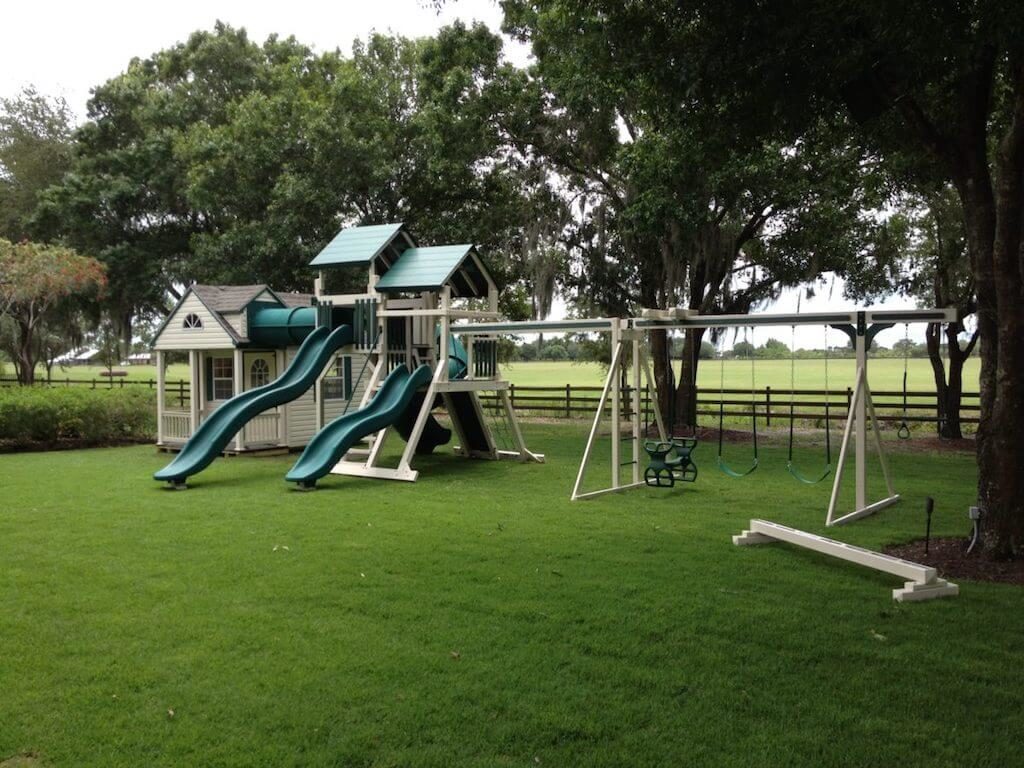
Safety
Grass is the least impact-absorbing material on this list. Grass is considered an inappropriate playground surface type by the U.S. Consumer Product Safety Commission. As grass gets worn down, it becomes less shock-absorbant and doesn’t offer much protection against falls. Grass can also be a slippery surface when wet, and may even develop uneven spots, which can cause children to trip.
Cost
Grass may seem like the least expensive option, but due to the large amount of maintenance required, it can end up being the most expensive option over time.
Maintenance
Grass requires constant upkeep, including mowing, weeding, watering, and fertilizing. All of this upkeep can be costly and time-consuming, making grass one of the most difficult to maintain options. Watering grass may also cause damage to wood structures or rusting to metal structures, which is another reason why vinyl swing sets are the premium option.
Visual Aesthetic
Grass can be very aesthetically pleasing, as it can be part of your landscape. While some people think it may look the best visually, the levels of maintenance and lack of safety can offset this advantage.
Artificial Grass or Turf
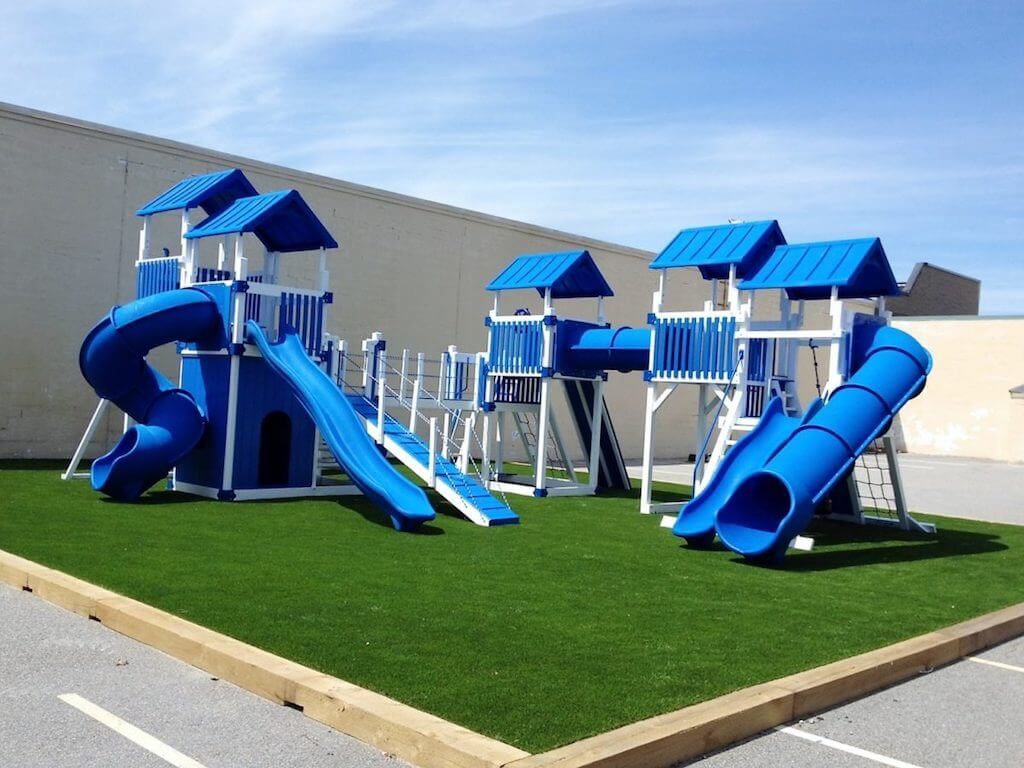
Safety
Artificial grass offers better drainage than regular grass, and therefore provides better slip-resistance. Turf also offers a level playing surface that is slightly more cushioned than grass. However artificial grass will get hotter in the sun than regular grass. Turf does not offer much impact-absorption, so it is not always recommended as a surface with playground structures that are high off of the ground. The exact amount of impact absorption can vary greatly, as there are different types of shock-pads that can be installed underneath. If you choose this option, look into the type of padding that’s offered.
Cost
Artificial grass has a high installation price, but requires less maintenance later on. A small amount of maintenance can save you time and money over the long term.
Maintenance
Once artificial grass is installed, there’s not much maintenance required. Washing the material may be necessary as it gets dirty, and repairs may need to be made if the material becomes damaged.
Visual Aesthetic
Artificial grass can be visually pleasing and complementary to your landscape, as it looks like regular grass. It’s always green, so it always looks fresh as well. This may be a downside, however, if the grass landscaping adjacent to the turf is not well-kept. The artificial grass will look out of place if the surrounding grass is browning.
Compare Each Swing Set Surface Material
We’ve put together a comparison chart to help summarize and visualize the differences, advantages, and disadvantages of each type of surfacing material to help you determine what to put under your swing set.
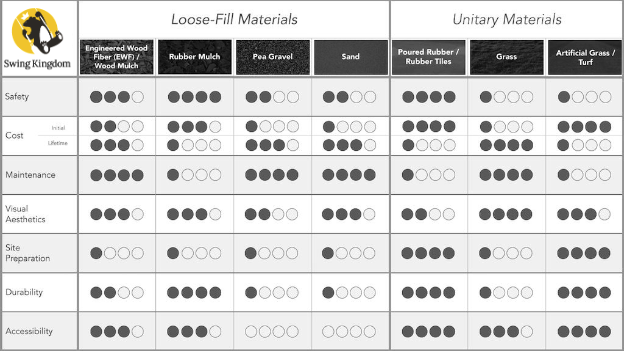
*Note: All fall protection data is sourced from the U.S. Consumer Product Safety Commission’s Public Playground Safety Handbook.*
This blog was originally published on 12/19/19. It was updated on 5/4/23.

